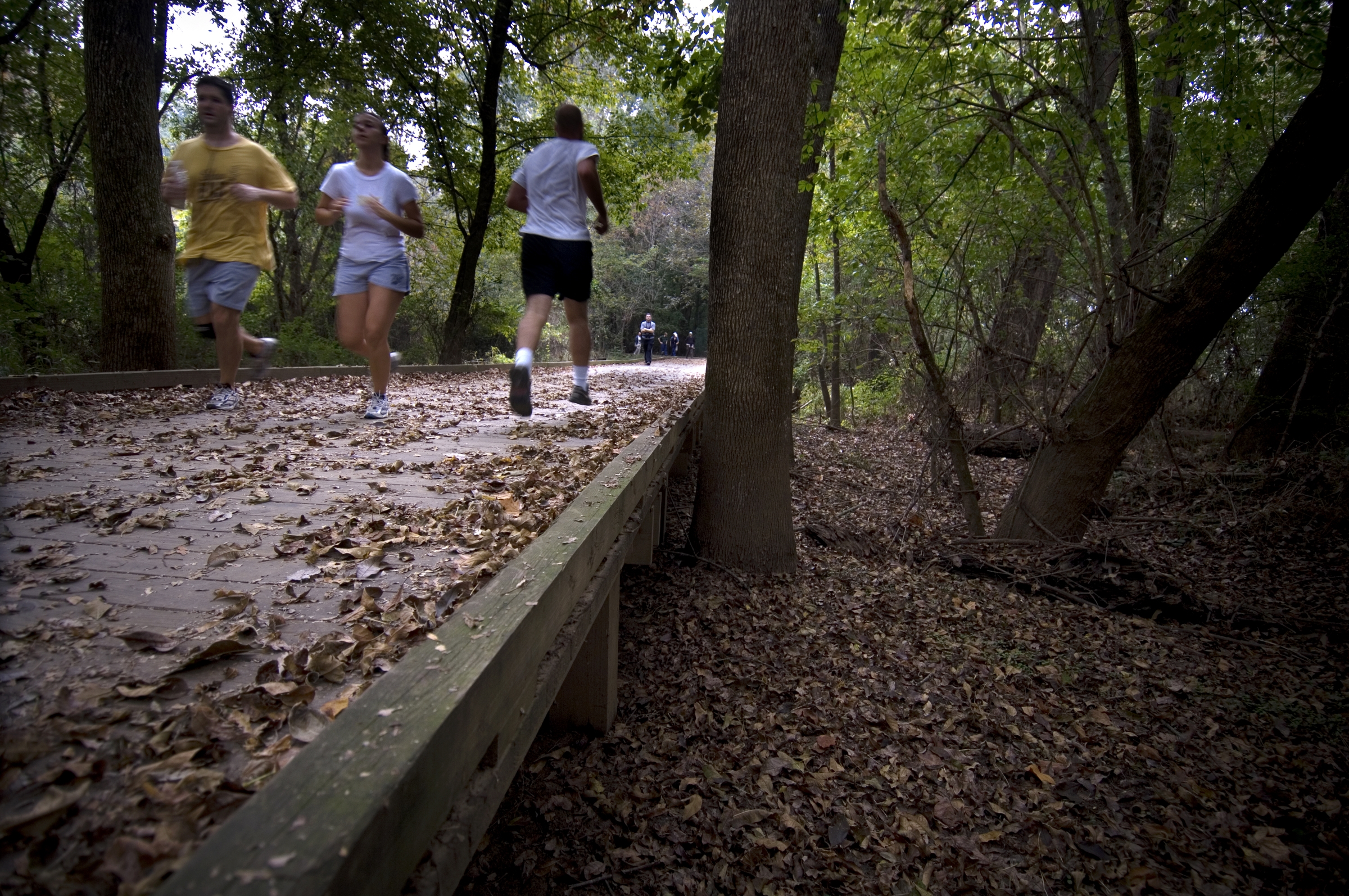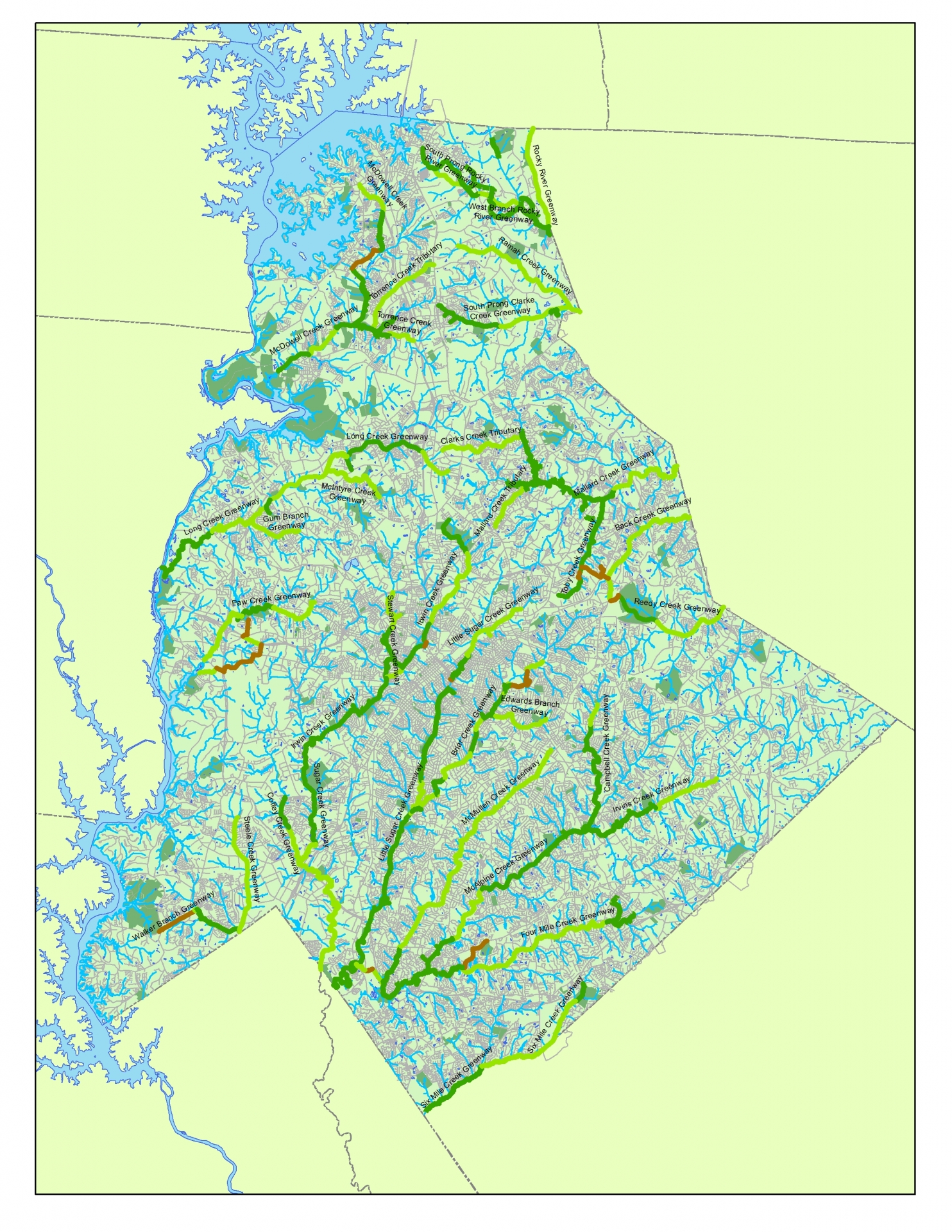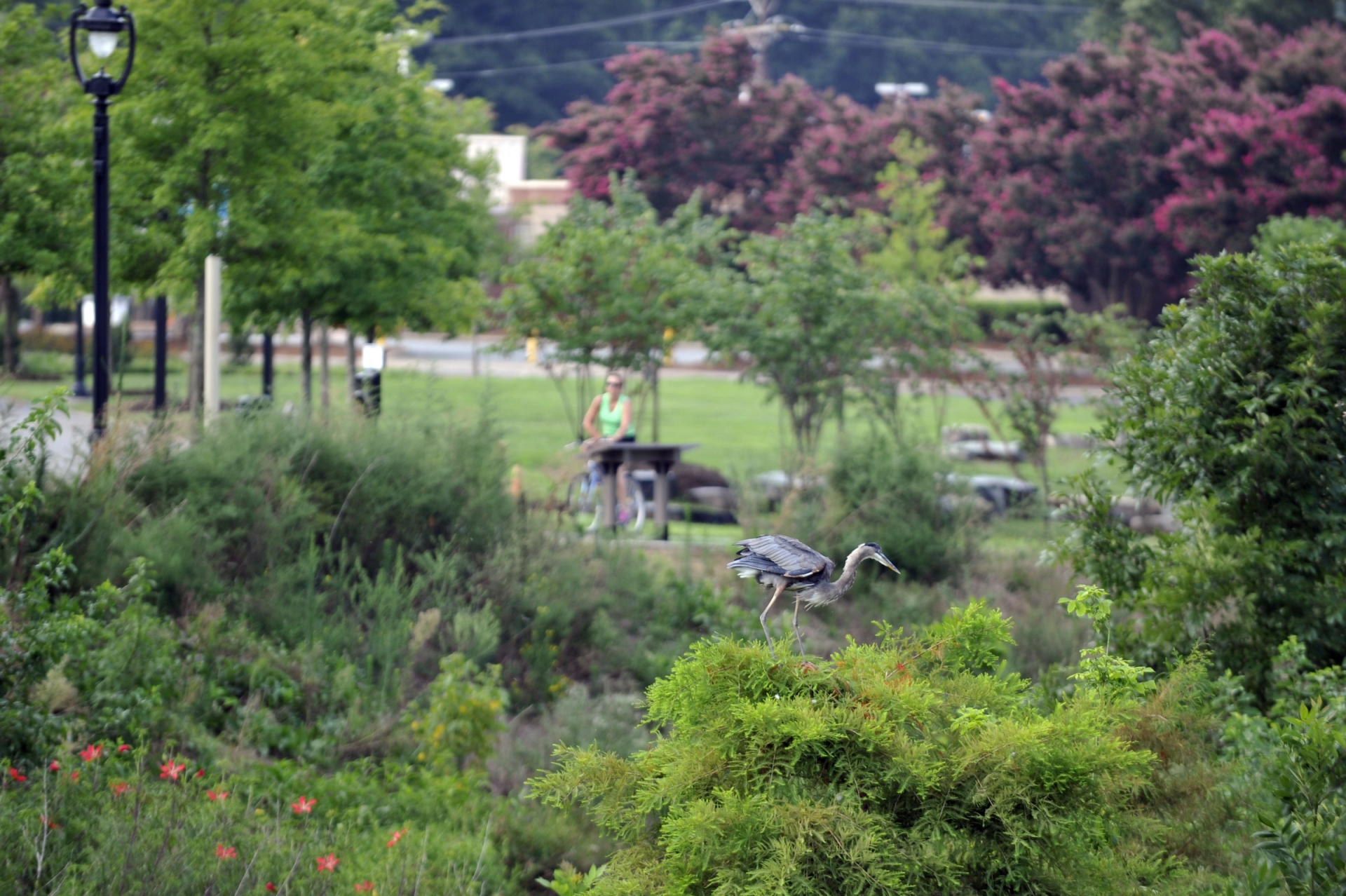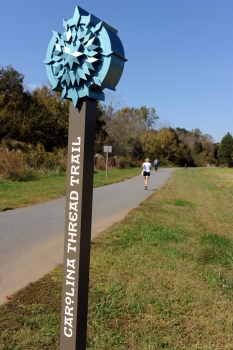By Mae Israel
At least three weekday mornings plus Saturdays, year-round, Virginia Watson is outside on one of Mecklenburg County’s greenways, walking at least 20 miles with a buddy, enjoying the scenery, the sounds of nearby creeks and a sense of community with other walkers.
“I like to greenway hop,” says Watson, a retired assistant principal in Charlotte public schools, who most often heads to the Mallard Creek Greenway in the University City area but also travels uptown and to other Charlotte neighborhoods. “I like the outdoors. I like to see the occasional animals that cross your path. I look forward to seeing the familiar faces of people who are out taking advantage of the greenways and working on their health, too.”
Decades ago, many county residents couldn’t imagine the role greenways could play. Homeowners feared crime and strangers too close to their yards. Dairy farmers worried greenways near pastures would scare the cows
Watson’s fondness for greenways is widespread in Mecklenburg and elsewhere across the country, where residents increasingly are flocking to these linear parks to walk, run or bike. The signature Little Sugar Creek Greenway – a portion of which meanders near uptown Charlotte offering both skyline and nature views – attracts hundreds to festivals, races and other community activities. A few greenways are so popular on weekends that parking spaces near main entrances are a hot commodity.
Today, the greenways are closely linked in many residents’ minds with the county’s various creeks. But more than 30 years ago, many Mecklenburg residents couldn’t imagine the role of greenways in providing open space or their contribution to the preservation of creeks and wetlands and to improved water quality. Some homeowners complained about strangers being too close to their backyards or a possible increase in crime. Dairy farmers worried greenways near their pastures would scare the cows.
Now stretching 40 miles, Mecklenburg’s paved and gravel greenways offer not only recreation and transportation opportunities, but act as natural buffers to help reduce the impact of flooding, improve water quality and provide wildlife habitat. More than half of the greenway mileage, about 28 miles opened for public use in the last decade.

Near uptown Charlotte, a portion of the Little Sugar Creek Greenway has been a magnet for restaurants and businesses. Subdivision developers, eager to tout a greenway as a neighborhood amenity, today willingly donate property to build them or advertise the proximity of existing paths to potential buyers. In a recent county survey, residents ranked greenways as a top priority for local recreation, reflecting a societal shift toward activities promoting health and wellness.
“Greenways are the ultimate amenity for us,” says W. Lee Jones, a manager in the Mecklenburg County Department of Parks and Recreation. “They provide recreation, transportation, education and appreciation of the environment. What better way to enjoy a city than by walking or biking through it?”
The county’s ambitious greenway plan calls for building a 203-mile linked “green necklace” that will allow residents to travel, primarily along creeks, from the towns of Davidson, Cornelius and Huntersville in north Mecklenburg through Charlotte to Pineville, Matthews and Mint Hill in the south. Parks officials estimate at least $40 million has been spent to buy property and develop greenways in partnership with creek restoration projects. The goal, park officials say, is to open at least six miles of greenways annually.
As the number of greenways has grown, a regional movement has emerged to provide a trail network connecting cities, towns and natural areas in 15 counties in North Carolina and South Carolina. The Carolina Thread Trail is planned to link an estimated 2.3 million people with 1,400 miles of trails, including some of Mecklenburg’s greenways. In Charlotte, officials are proposing a multi-use trail across the city to connect greenways. Last year, voters approved a bond referendum allocating $5 million to begin planning it.
Mecklenburg’s greenway system, one of the oldest in North Carolina, is well regarded nationally and is a leader in the Southeast, says Chuck Flink, a national greenway planner and designer who helped update two county greenway master plans. “It’s a fantastic system and it is one that has been embraced by multiple leadership groups.”
Of course, there have been challenges.
The greenways compete for funding in a growing county facing demands for a variety of recreation options, and work on the system slowed during the past five years, as the county wrestled with the financial impact of the Great Recession.
“We have accomplished quite a lot,” says Owen Furuseth, an associate provost in academic affairs and professor of geography at UNC Charlotte, who served in the 1990s on an advisory board for greenways. “The glass is half full, but as a proponent I look at it has half empty, too. Greenways were getting resources, but for some of us it was not enough.”
The EARLY YEARS
McAlpine Creek Greenway opened in 1979 as the county’s first, the culmination of 15 years of assembling land primarily with federal funds. While the idea for that greenway had surfaced in a 1965 plan, work on a countywide system along 20 creeks did not begin until 1980, when officials adopted a master plan based on the research of UNC Charlotte graduate geography student Joan Sigmon. It has been updated several times, most recently in 2008.
Fountain Odom, Sr. – a former Mecklenburg County commissioner and state senator who began advocating for greenways as a member of the parks and recreation commission in the 1970s – remembers the early opposition as well as the effort by some officials, particularly former commissioner Liz Hair, for whom a part of a greenway is named, to rally public support.
“The main thing was to have them established along all the major streams and creeks,” says Odom. “It was like being a good neighbor. The greenways provided good environmental progress for water quality and also good public health policy.”
But the initial plans were halted in 1981 after residents in the Idlewild Farms neighborhood rejected a greenway along Campbell Creek and dairy farmers protested one proposed in north Mecklenburg. Officials later hired a public relations firm to sell the greenway story and win public support.
The land used for greenways is generally off limits to development because of potential flooding. Officials estimate at least 60 percent of greenway property, both developed and undeveloped, has been donated by developers. The county currently owns an estimated 1,900 acres of undeveloped property along the creeks.
In many ways, development of the greenway system has mirrored the county’s growth.
Officials and planners during much of the 1980s focused on buying land, targeting areas of projected population growth. They decided to distribute greenways throughout the county rather than focusing on longer segments in a few neighborhoods. While some communities across the country adopted ordinances requiring mandatory donation of floodplain property during the development process, including Greensboro and Guilford County, that idea never gained traction in Mecklenburg. Other jurisdictions, including Wake County, Raleigh, Kannapolis, Lincolnton and Belmont, also require subdivision developers to either donate land or pay a fee for parks and recreation.

When it started, the greenway program was a county government initiative. In 1991, however, the Charlotte and Mecklenburg parks and recreation departments merged under county control during a larger consolidation of several city and county services. Funding for greenway land acquisition and construction then had to be weighed against the need for ball fields, recreation centers and parks.
“We had to blend the two cultures,” says former parks and recreation director Wayne Weston. “There was a lot of citizen involvement to set new priorities. Greenways slowed down for a few years.”
Now, says Weston, who oversaw recreation programs for more than 20 years beginning in 1985, “You have a whole generation that has been introduced to nature because of greenways and understand the importance of preservation.”
Voter-approved bond referendums in the 1990s and in 2004, with money designated for greenways, moved the county’s program from primarily land acquisition to construction and opening of paths.
THE SYSTEM EXPANDS
Nearly 28 miles have been completed since 2005, opening access to an increasing number of greenways, as more and more people seek to spend more time outdoors.
“The vision,” says Jones, of the parks and recreation department, “is being realized.”
At 40 miles, Mecklenburg’s greenway system isn’t the largest in North Carolina and is smaller than some in similar-sized cities across the country. Raleigh, for example, has more than 100 miles of greenways in a system started before Mecklenburg’s. Greensboro has 80 miles. Neither of those cities’ greenways focuses primarily on creeks and streams.
As Mecklenburg’s program expands, it is becoming more expensive, according to Jones. Land costs are rising, as well as prices for asphalt and other materials used for the paths. The estimated cost of each greenway mile is increasing from about $1 million to between $1.5 and $1.7 million.
The county’s 2014-18 capital improvement plan includes an additional 22 miles of greenways, either for buying property, designing or building. Whether all the projects are built depends on funding approval for each of those years by county commissioners.
Nancy Brunnemer is proud of the steady development of greenways. She remembers when she walked along much of the creek side property after arranging for its purchase or donation, wearing boots and carrying a machete. As the first county greenway planner, she was on the front line of turning the plans into paths, and helping, she says, improve the county’s quality of life.
“It was like putting together a jigsaw puzzle, piece by piece,” says Brunnemer, who retired a few years ago. “It’s been a coordinated effort between a lot of people. Now, it’s always good to hear that people love the greenways.”




